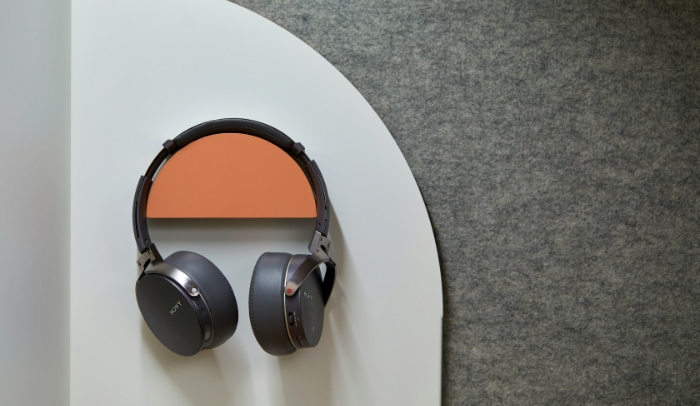Why Do My Headphones Sound Muffled? Solving the Audio Puzzle

Have you ever put on your favorite track, only to be met with sound that's less crisp and clear than you remember? It's a frustration many of us face: one day our headphones bring us the perfect harmony of bass and treble, and the next, they're dishing out muffled tunes.
This puzzling shift can happen to any pair, from the high-end models you saved up for to the trusty earbuds you've had for ages. In this article, we'll unravel this audio mystery.
We'll dive into the common culprits behind this decline in sound quality and offer practical solutions.
Quality of Headphones
When your headphones start to sound muffled, the first thing to consider is their quality. The craftsmanship and materials used in manufacturing headphones play a crucial role in determining their sound fidelity.
Build and Design Influence Sound
High-quality headphones typically feature superior design and materials that enhance sound clarity. They often come with well-engineered drivers, optimized acoustic chambers, and high-grade materials that ensure a more precise sound output.
On the other hand, budget-friendly headphones might cut corners in these areas, leading to less crisp sound.
High-End vs. Budget Headphones
High-end headphones are designed with sound fidelity as a priority. They offer features like noise isolation, wider frequency response, and high-quality drivers that accurately reproduce sound.
Budget headphones, while affordable, may compromise on these features, resulting in a less detailed audio experience. This doesn't mean all budget headphones are prone to muffled sound, but they may not deliver the same level of clarity as their high-end counterparts.
The Role of Materials
The materials used in headphones significantly impact their sound quality. For instance, headphones with padded ear cups made of high-quality foam and fabric can provide better sound isolation, enhancing the audio clarity.
In contrast, cheaper materials may not isolate sound effectively, leading to a muffled audio experience.
Understanding Sound Drivers
The driver in a headphone is the component that converts electrical signals into sound. Larger and better-quality drivers usually produce clearer and more detailed sound.
High-end headphones often boast drivers that deliver a balanced and dynamic sound range, whereas smaller, lower-quality drivers in budget headphones might struggle to provide the same level of clarity.
Durability and Long-Term Performance
Lastly, the durability of headphones is linked to their build quality. Higher-quality headphones are not only about superior sound but also about lasting longer without degradation in performance.
This means you're less likely to encounter issues like muffled sound due to wear and tear over time.
Wear and Tear
Even the best headphones are not immune to the effects of time and regular use. Over time, various components of your headphones can wear out, affecting their sound quality.
Impact of Regular Use on Headphones
Every time you use your headphones, they experience a bit of wear. This wear can accumulate, leading to various issues.
For instance, the padding on the ear cups might get compressed or the cables might develop kinks or frays. These seemingly small changes can significantly affect the sound quality, often leading to a muffled audio experience.
Common Components Prone to Damage
Several parts of your headphones are particularly vulnerable to wear and tear. The speaker diaphragm, a thin membrane that vibrates to create sound, can lose its elasticity or get punctured, leading to distorted sound.
Similarly, the wiring within the headphones can become damaged, especially at common stress points like the jack or where the cable connects to the ear cups.
The Role of Cable and Connector Wear
For wired headphones, the cable and connectors play a vital role in sound transmission. Over time, these can become loose or corroded, leading to poor connection and muffled sound.
This is especially common in the 3.5mm jack or USB connectors that are frequently plugged in and out.
Environmental Effects on Headphones
Your headphones' environment can also contribute to wear and tear. Exposure to extreme temperatures, moisture, or even rough handling can speed up the degradation of materials and electronic components.
This environmental wear can manifest as changes in sound quality, including muffled audio.
Signs of Wear and How to Spot Them
Recognizing the signs of wear can help you address them before they significantly impact sound quality. Look for physical signs like frayed cables, loose connectors, or damaged padding.
Also, pay attention to changes in sound, such as distortions, crackling, or a decrease in volume.
Earwax and Debris Build-up

A less considered but common reason for muffled sound in headphones is the build-up of earwax and debris. This is particularly true for in-ear headphones, which are directly inserted into the ear canal.
Over time, earwax and other particles can accumulate on the earbuds, affecting the sound quality.
Understanding the Impact of Earwax on Sound
Earwax is a natural substance produced by the body, and its accumulation on headphone speakers can block sound waves, leading to muffled audio. This blockage can be gradual, so the decrease in sound quality might not be immediately noticeable.
However, as more earwax builds up, the sound can become significantly impaired.
Debris Accumulation in Over-Ear and On-Ear Headphones
While in-ear headphones are more susceptible to earwax, over-ear and on-ear headphones can also gather dust and debris. This usually accumulates on the outer parts of the headphones and can seep inside, affecting the drivers.
Dust and debris can also clog the mesh screens that cover the speakers, leading to a drop in sound clarity.
Safe Cleaning Methods for Headphones
Regular cleaning of your headphones is essential to prevent muffled sound caused by earwax and debris. For in-ear headphones, gently wipe the earbuds with a dry, soft cloth.
Avoid using sharp objects to remove earwax, as they can damage the delicate components. For over-ear and on-ear headphones, use a soft brush to gently remove dust from the mesh and surfaces.
Avoiding Earwax Build-up
To minimize earwax build-up, it's a good practice to clean your ears regularly and properly, avoiding the pushing of earwax deeper into the ear canal. Additionally, storing your headphones in a clean, dry place can prevent the accumulation of dust and debris.
The Importance of Regular Maintenance
Regular maintenance of your headphones is not just about prolonging their lifespan, but also about ensuring consistent sound quality. By keeping your headphones clean from earwax and debris, you can enjoy a clearer and more immersive audio experience.
Software and Equalizer Settings
Often overlooked, software settings on your device can significantly impact how your headphones sound. Incorrect settings, especially in the equalizer, can lead to a muffled audio experience.
Role of Software in Sound Quality
The software that controls your audio output, whether it's a music player on your phone or a sound manager on your computer, plays a key role in sound quality. These software tools process the audio before it reaches your headphones, and incorrect settings can distort or muffle the sound.
Navigating Equalizer Settings
The equalizer is a feature found in most audio playback devices and applications. It allows you to adjust the balance of different frequency components in your audio.
Improperly set equalizers can overemphasize or underemphasize certain frequencies, causing your music to sound off, including being too bass-heavy or too treble-focused, which can be perceived as muffled.
Common Misadjustments and Their Impact
Some common misadjustments include having the bass or treble turned up too high or having certain frequencies completely muted. These settings can mask or overwhelm other sounds in your audio, resulting in a lack of clarity or a muffled sound.
Steps to Optimize Your Equalizer
To optimize your equalizer settings, start by resetting it to the default or a flat setting, where all frequencies are balanced. From there, you can make small adjustments to suit your personal preferences and the genre of music you're listening to.
Remember, small tweaks can make a big difference.
Checking for Software Updates
Occasionally, the issue might be due to outdated software. Ensure your device’s audio driver and music player are up to date.
Software updates often include bug fixes and improvements that can enhance sound quality.
Audio Source Quality

The quality of the audio source is a critical factor in how your headphones sound. If the original audio file or stream is of poor quality, even the best headphones won't be able to produce clear sound.
Impact of Compressed Audio Files
Many digital audio files are compressed to reduce their size for easier storage and streaming. This compression often involves removing some audio data, especially at higher and lower frequencies.
While this makes files smaller, it can also lead to a loss in sound quality, resulting in muffled or flat audio playback.
Streaming Quality and Its Effects
Streaming music is incredibly convenient, but the quality of the stream can vary greatly. Lower bitrate streams, often used to save data or buffer faster, can significantly degrade audio quality.
This is particularly noticeable with complex or high-frequency sounds, which can become distorted or muffled.
Choosing High-Quality Audio Sources
To ensure the best audio experience, opt for high-quality audio sources. Look for uncompressed or minimally compressed file formats like FLAC or WAV when downloading music.
When streaming, choose the highest quality setting available, especially if you're using high-end headphones.
How Different Genres Are Affected
Different music genres can be affected differently by audio source quality. Genres with a lot of bass or intricate high tones, like classical or electronic music, can lose much of their depth and detail if the source quality is poor.
This can make the music sound muffled and less dynamic.
Verifying Source Quality
When experiencing muffled sound, check the quality of your audio source. If you're streaming, see if there's an option to increase the stream quality.
For downloaded music, check the file format and bitrate. Upgrading these can lead to a noticeable improvement in sound quality.
Connectivity Issues
Connectivity issues, particularly with wireless headphones, can significantly impact sound quality. Interferences or problems with the Bluetooth connection often result in a muffled sound.
Bluetooth and Wireless Interference
Wireless headphones rely on Bluetooth technology to connect to your device. This connection can be disrupted by physical obstacles, distance, or interference from other wireless devices.
When the connection is weak or unstable, it can lead to audio dropouts or a muffled sound.
Recognizing Connectivity Problems
Common signs of connectivity issues include intermittent sound, distortions, or a significant drop in audio quality. These problems can often be intermittent, making them more challenging to diagnose.
If you notice these symptoms, connectivity could be the issue.
Troubleshooting Wireless Headphones
To troubleshoot, start by ensuring your headphones are within a reasonable range of your device. Remove any physical obstructions and turn off other devices that might cause interference.
Re-pairing your headphones with your device can also help resolve connectivity issues.
Wired Headphones and Connection Woes
For wired headphones, the quality of the connection depends on the condition of the cable and the headphone jack. A damaged or loose cable can result in poor sound quality, including muffled audio.
Regularly inspect your cable and connectors for signs of wear or damage.
Optimizing Your Connection
For the best audio experience, make sure your wireless headphones have a stable connection and are compatible with your audio source. For wired headphones, using a high-quality cable and ensuring a secure connection can make a significant difference in sound quality.
Conclusion
Muffled sound in headphones can be a source of frustration, but it's often a problem with a solution. We've journeyed through various potential causes, from the quality of the headphones themselves to the impact of wear and tear, and even the influence of earwax and debris.
Software and equalizer settings, along with the quality of the audio source, play significant roles too. Lastly, connectivity issues, whether for wireless or wired headphones, can be a culprit.
Each of these factors offers a path to improving your audio experience. Regular maintenance and careful handling can extend the life and performance of your headphones.
Adjusting software settings and ensuring high-quality audio sources can dramatically enhance sound clarity. And addressing connectivity issues can resolve many cases of muffled sound.
Remember, headphones are more than just accessories; they're gateways to the world of sound. By paying attention to these aspects, you can ensure your gateway remains clear, delivering the crisp and vibrant audio you deserve.


